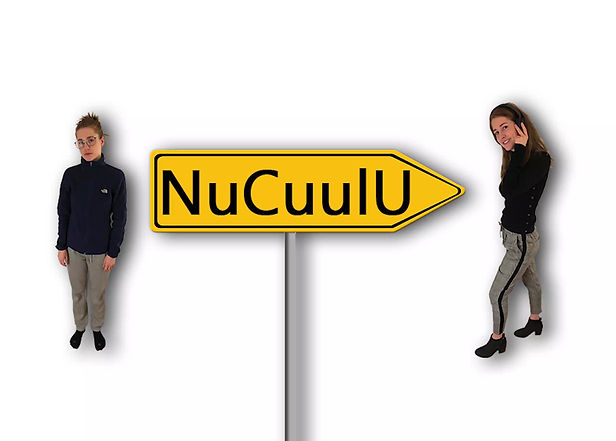The NuCuulU Project
Course: Information Design Studio III: Designing Interactive Systems
Tasked with designing an experience in a retail environment that involves dark patterns in proxemic interactions, I designed a system that utilizes a shopper's online shopping and social media data to create a virtual newer, cooler version of the shopper that will show up in front of stores as the shopper walks by. Using Wiarframe (an augmented reality tool), Adobe Photoshop, Audition, and Premiere Pro, I created a video demonstrating and explaining the NuCuulU system.

How the NuCuulU System Uses Dark Patterns in Proxemic Interactions:
-
Captive Audience
-
While walking through a mall, shoppers are a captive audience as they walk through the hallways since they must use the hallways to enter and leave the mall, and to walk from one store to another. The NuCuulU system takes advantage of this situation by using proxemic sensing to understand where exactly the shopper is, in order to present the shopper (the captive audience) with visuals intended to coax the shopper into stores.
-
-
Attention Grabbing - the NuCuulU system uses three main strategies to grab a shopper's attention:
-
The entire purpose of showing the shopper a virtual cooler and sexier version of themselves wearing items from stores they're passing by is to grab their attention and seduce them into entering stores and purchasing products
-
When the shopper steps closer to a store's doors, the virtual cooler version of the shopper will become more intrusive in their field of vision and more difficult to ignore
-
As a shopper reaches a store's doors, a virtual arrow with an urgent deal is displayed to grab the shoppers attention and to get them to walk into the store to realize the deal
-
The Design Process
Initial Design Ideas
After ideating a variety of designs involving proxemic interactions in a mall environment, I chose to expand on the idea where large ads, tailored to the shopper, are displayed as they walk through a mall while using a mall navigation app.
IDEA CHOSEN



Sketches of Design Variations
After my professor suggested modifying the design so that the system is not reliant on any technology used by the shopper, I sketched variations of a radically revised version of my initial idea. Rather than using ads, a virtual person or animal, tailored to the shopper's interests, will show up as they walk by stores. Instead of relying on a phone app to collect a shopper's information, the shopper's online shopping and social media data is used to generate a tailored experience.



DESIGN
VARIATIONS
CHOSEN
Finalizing the NuCuulU System Design
I decided to combine 2 of my design variations for my final design:
-
a hologram version of the shopper appears when the shopper walks past a store (variation #4)
-
a limited-time deal is offered when the shopper gets close to a store (variation #5)
-
the shopper high fives the hologram version of themselves to purchase the holograms outfit (variation #7)
After my professor encouraged me to consider various ways for the shopper to realize a deal, I came up with the idea that the shopper must walk through a store's doors to receive the offered deal.
I wanted to implement the design variation where the shopper high fives the hologram version of themselves to purchase the holograms outfit (variation #7), but due to complications with Wiarframe, I wasn't able to implement that idea.
Creating the Video
I used Wiarframe to create an augmented reality environment that demonstrates how the NuCuulU system works. Then I used a variety of Adobe offerings to create individual parts of the video, and to stitch them all together.
Wiarframe - Created augmented reality environment

Adobe Audition - Recorded voice recordings for the video

Adobe Photoshop - Created images for the video

Adobe Premiere Pro - Put the video together

Final Product

Reflection
I wanted to explore what the in-person, retail shopping experience might look like if technology were to be used to understand exactly what we want in life, and then used to literally dangle that vision, like a carrot, in front of us as consumers. This advertising idea is already used online as we’re flooded with ad images of people that we might aspire to look and be like, but what if we’re out shopping and the idealized version of ourselves becomes attainable, right then, right there, if we just open our wallets and pay for it. This is the vision behind NuCuulU, and I wanted to show how retail spaces can take advantage of having control over a consumer’s physical space and can grab their attention in a clever way to entice them to shop more!
I think this type of system would be extremely effective if it were to be implemented in real life. Regular advertising and influencers are effective at selling people products because people are susceptible to believing that purchasing products will make them cooler, better, and sexier. People’s online data is already used to generate targeted advertising and AR technology is becoming increasingly sophisticated, making the NuCuulU system a plausible idea for the near future, rather than an outlandishly futuristic idea.
The fact that the NuCuulU system is a fairly realistic technology for the not-too-distant future reveals that society has already become incredibly accustomed to, and has, to some degree, embraced microtargeted advertising based on personal data. This reveals that people are likely to welcome, or at least tolerate, more advanced and more intrusive advertising techniques. The NuCuulU system brings advertising into the 3D environment, and given the current climate of our society, I believe that people are ready to have it all!